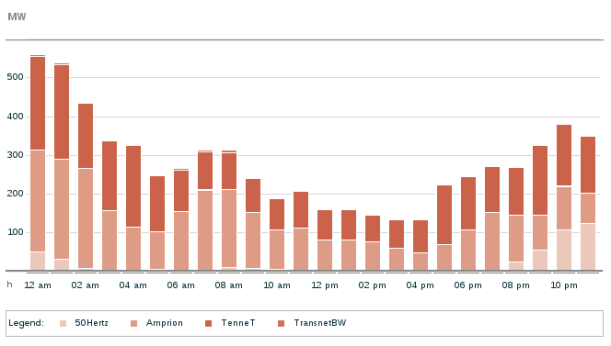By the end of 2022 Germany will have no nuclear power plants remaining. I have covered why this policy is folly elsewhere, so won’t cover it again here. Instead let us consider in a little detail how things will pan out in the next decade. To put the numbers in perspective I will estimate how much solar power will need to be added to replace the lost production due to each reactor being closed early (assuming a solar panel life span of 25 years and capacity factor of 10%). I’m using solar, not wind because the load factor for wind farms will be quite dependent on how much offshore wind is built, but if you want onshore wind figures just divide by 2.5.
Here’s the timetable of future reactor shutdowns:
2015: 1 reactor closes
Reactor: Grafenrheinfeld, (1.3 GW)
Average load factor: 85.8%
Original shut down date: 2028
Solar required to replace lost production: 6.8 GW
2017: 1 reactor closes
Reactor:Â Gundremmingen-BÂ (1.3 GW)
Average load factor: 83.6%
Original shut down date: 2030
Solar required to replace lost production: 6.8 GW
2019: 1 reactor closes
Reactor:Â Phillipsburg-2Â (1.4 GW)
Average load factor: 88.3%
Original shut down date: 2032
Solar required to replace lost production: 7.3 GW
2021: 3 reactors close
Reactor:Â Gundremmingen-CÂ (1.4 GW)
Average load factor: 88.3%
Original shut down date: 2030
Solar required to replace lost production: 5 GW
Reactor: Brokdorf (1.4 GW)
Average load factor: 88.2%
Original shut down date: 2033
Solar required to replace lost production: 6.7 GW
Reactor: Grohnde (1.4 GW)
Average load factor: 90.4%
Original shut down date: 2031
Solar required to replace lost production: 5.6 GW
2022: 3 reactors close
Reactor:Â Isar-2Â (1.4 GW)
Average load factor: 89.5%
Original shut down date: 2034
Solar required to replace lost production: 6.7 GW
Reactor: Emsland (1.3 GW)
Average load factor: 93.5%
Original shut down date: 2035
Solar required to replace lost production: 6.8 GW
Reactor:Â Neckarwestheim-2Â (1.3 GW)
Average load factor: 92.3%
Original shut down date: 2036
Solar required to replace lost production: 7.3 GW
Looking Ahead
In total Germany would need to build an additional 59 GW of solar power to replace the lost production of the shuttered nukes. This of course is a rather simplified view. The sun does not shine at 6 pm in Winter when Germany’s electricity demand peaks. And the wind does not always blow either. In fact Germany can probably rely on just a bit above zero wind power, so this lost nuclear production could be made up by building a large number of wind turbines and solar panels. However the lost capacity cannot be, a distinction many fail to recognise. Fossil fuelled (or biomass) power plants will need to be built. To see this consider that Germany has over 30 GW of wind turbines, yet at 6pm on January 14th 2013 barely 0.5 GW, or 1.5% of capacity, was feeding into the grid.
Things can be even worse, as can be seen on October 24th 2012 when wind power was a mere 134 MW, 0.5% of total capacity:
So, to replace its 12 GW of nuclear with renewables Germany will have to build enough renewable capacity to replace lost production and enough fossil fuel capacity to keep the lights on when it is not windy. It would appear that the dreams of Angela Merkel to put a stop to rising electricity prices will remain just that.
Authored by:
Robert Wilson
Robert Wilson is a PhD Student in Mathematical Ecology at the University of Strathclyde.
His secondary interests are in energy and sustainability, and blogs on these issues at Carbon Counter.


No comments:
Post a Comment